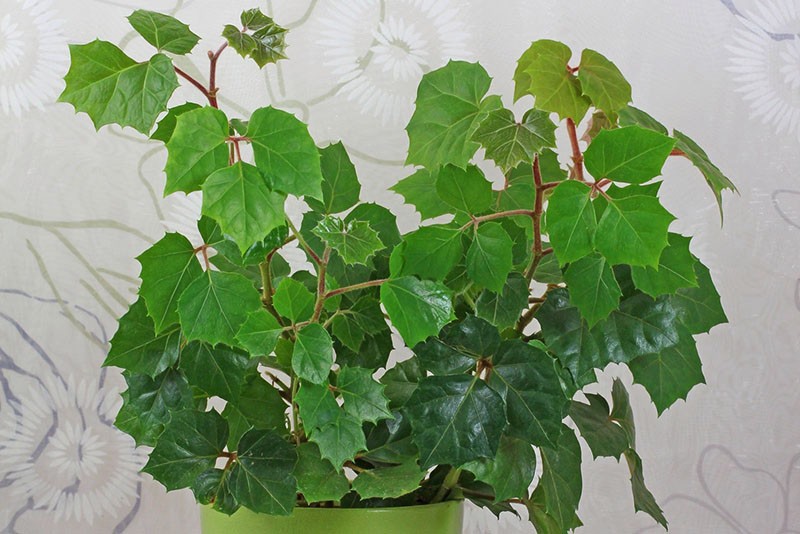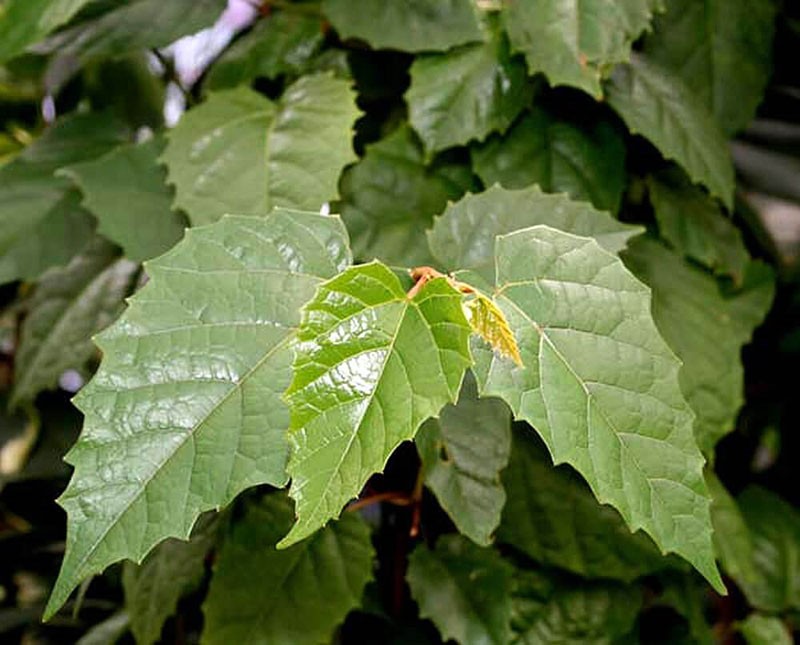Dignified home grapes - a houseplant for a stylish interior
 Lush landscaping of the premises is an original solution for creating everyday comfort. Experienced designers often use home grapes, a houseplant of a climbing nature. It cleans the air wonderfully, which is good for health. For several years, culture is able to completely wrap around windows, walls and furniture. Lush greenery exudes a pleasant tart aroma, transforming the room into a miniature natural landscape. Let's get to know this wonderful plant better.
Lush landscaping of the premises is an original solution for creating everyday comfort. Experienced designers often use home grapes, a houseplant of a climbing nature. It cleans the air wonderfully, which is good for health. For several years, culture is able to completely wrap around windows, walls and furniture. Lush greenery exudes a pleasant tart aroma, transforming the room into a miniature natural landscape. Let's get to know this wonderful plant better.
Gourmet homemade grapes - the houseplant of all time

These varieties are considered the most popular for home cultivation.:
- "Antarctic" (heart-shaped foliage with a jagged frame);

- "Quadrangular" (dense shoots, three-lobed leaf plates);

- "Two-color" (the front side of the leaf is colored dark green and covered with a grayish blotch, the back has a maroon shade);

- "Rhombic" (the plate consists of 3 elements in the form of a diamond, covered with dark red villi).

Most of them have their whiskers transformed into suckers. Thanks to this, the indoor plant - home grapes confidently masters the "open spaces" of the dwelling. When in an enclosed space, it usually does not bloom. The stems are fragile. Therefore, experts advise growing it in one place.
A similar crop is the Vuagnier tetrastigma, which is characterized by thick stems, large foliage and up to 30 m long. Usually the plant is grown in spacious greenhouses located in the territory of botanical gardens.
Secrets of growing crops
 The breeding scheme for decorative indoor grapes is quite simple. Even an inexperienced greenery aficionado will successfully grow it in their home or office. There are several rules that help you navigate when placing vines, proper planting, reproduction and loving care. We will analyze each procedure in detail, taking into account all the details and nuances.
The breeding scheme for decorative indoor grapes is quite simple. Even an inexperienced greenery aficionado will successfully grow it in their home or office. There are several rules that help you navigate when placing vines, proper planting, reproduction and loving care. We will analyze each procedure in detail, taking into account all the details and nuances.
A place under the sun
 Since the homeland of domestic grapes is tropical forests, similar conditions are created in an enclosed space. In order for it to receive enough light, it is placed in a room whose windows are directed to the west or east. The south side is allowed provided that during the heat of summer, create additional protection from direct sunlight. When using the northern part, the indoor flower - grapes - is "settled" next to the artificial lighting. The application of the rules for placing culture contributes to the achievement of the main goal - to have a tropical vine in the house.
Since the homeland of domestic grapes is tropical forests, similar conditions are created in an enclosed space. In order for it to receive enough light, it is placed in a room whose windows are directed to the west or east. The south side is allowed provided that during the heat of summer, create additional protection from direct sunlight. When using the northern part, the indoor flower - grapes - is "settled" next to the artificial lighting. The application of the rules for placing culture contributes to the achievement of the main goal - to have a tropical vine in the house.
The home grape plant does not take root well in places where there are drafts.
Microclimate
 Most varieties of culture prefer a fairly warm habitat. The optimum temperature ranges from 22 to 25 ° C. In the cold season, a decrease of about 5 ° C is allowed.
Most varieties of culture prefer a fairly warm habitat. The optimum temperature ranges from 22 to 25 ° C. In the cold season, a decrease of about 5 ° C is allowed.
Young bushes that are not attached to the support are taken out to fresh air or balcony... This is usually done in good weather in late spring, summer and early fall. Flowerpots are placed under the canopy of spreading trees, where there are no strong drafts.
The Antarctic Cissus variety thrives even at temperatures of + 5 ° C.
An important aspect of growing a wild grape houseplant is the regulation of air humidity. Of course, indoors it is impossible to create a microclimate inherent in tropical forests. However, regular spraying will “remind” the culture of its “historical homeland”. As a token of gratitude, the plant will release many shoots, strewn with glossy rich green foliage.
Ideal soil composition
 Experts recommend preparing fertile soil immediately before planting wild indoor grapes.
Experts recommend preparing fertile soil immediately before planting wild indoor grapes.
It includes:
- leaf humus;
- sod land;
- peat;
- humus;
- coarse sand.
All components are taken in the same amount. Mix thoroughly, disinfect with potassium permanganate solution. Drainage material from expanded clay is placed at the bottom of the pot. Thanks to this, the culture will be protected from moisture stagnation, which leads to rotting of the root system.
Planting and breeding
 When the preparatory work is completed, they begin to plant indoor grapes. The existing stalk is carefully placed in the center of the prepared container. The root zone is reliably compacted. Moisturize abundantly on top. As it grows, the culture is transplanted into new pots for the first five years. An adult plant is renewed every 2 years.
When the preparatory work is completed, they begin to plant indoor grapes. The existing stalk is carefully placed in the center of the prepared container. The root zone is reliably compacted. Moisturize abundantly on top. As it grows, the culture is transplanted into new pots for the first five years. An adult plant is renewed every 2 years.
 Fans of lush greenery don't stop at growing a single tropical vine. They create stylish group compositions in their homes, apartments and offices.
Fans of lush greenery don't stop at growing a single tropical vine. They create stylish group compositions in their homes, apartments and offices.
The successful propagation of indoor grapes consists of a series of sequential procedures:
- on a biennial bush, the tops with two buds are cut off;
- the stalk is placed in a container with clean water;
- leave on the windowsill until the roots appear.
 Prepare a pot with a fertile substrate. A young seedling is planted in the classical way. For 4 weeks, the plant is regularly moistened and sprayed. If desired, the cuttings are planted immediately into the ground, without waiting for the formation of roots.
Prepare a pot with a fertile substrate. A young seedling is planted in the classical way. For 4 weeks, the plant is regularly moistened and sprayed. If desired, the cuttings are planted immediately into the ground, without waiting for the formation of roots.
It is advisable to plant several copies in one container in order to get a lush vine.
Caring for a tropical guest
The systematic care of indoor grapes at home determines its external attractiveness and speed of development. Therefore, experts advise beginners not to relax, but to follow generally accepted rules.
Humidification mode
 "Aliens" from distant tropical forests do not forget about their homeland. They still need abundant watering. They are given special attention throughout the warm season. The soil surface is moistened as it dries. A warm "shower" is regularly arranged for sheet plates.
"Aliens" from distant tropical forests do not forget about their homeland. They still need abundant watering. They are given special attention throughout the warm season. The soil surface is moistened as it dries. A warm "shower" is regularly arranged for sheet plates.
 With the onset of cold weather, the process of development of an indoor flower slows down significantly. In order for the wild grapes in the apartment to look beautiful and magnificent in winter, competent care is required for them. During this period, it is watered and sprayed less often, trying to regulate the amount of moisture. Violation of the rules usually leads to rotting of the root system, the appearance of yellow foliage and even the death of the culture.
With the onset of cold weather, the process of development of an indoor flower slows down significantly. In order for the wild grapes in the apartment to look beautiful and magnificent in winter, competent care is required for them. During this period, it is watered and sprayed less often, trying to regulate the amount of moisture. Violation of the rules usually leads to rotting of the root system, the appearance of yellow foliage and even the death of the culture.
In autumn and winter, the plant is watered no more than 2 times a week with increased heating.
Kind feeding
 During active growing season, the culture is watered with complex fertilizers. Usually they are brought in from April to September. Top dressing is purchased in specialized stores. The packaging must be marked “for non-flowering crops”.
During active growing season, the culture is watered with complex fertilizers. Usually they are brought in from April to September. Top dressing is purchased in specialized stores. The packaging must be marked “for non-flowering crops”.
In winter, indoor grapes do not need feeding.
Formative pruning
 To preserve beauty, indoor culture is regularly examined. Dry and yellowed foliage is carefully removed.Long shoots are shortened. The tops are pinched. Thanks to this technology, the tropical guest is constantly evolving. In a short time, she will be able to reliably root and release a huge number of young shoots.
To preserve beauty, indoor culture is regularly examined. Dry and yellowed foliage is carefully removed.Long shoots are shortened. The tops are pinched. Thanks to this technology, the tropical guest is constantly evolving. In a short time, she will be able to reliably root and release a huge number of young shoots.
Diseases and pests
 Unfortunately, even ampelous cultures do not stay away from fungal infections and gluttonous insects. If leaves dry on a bush of indoor grapes, it means that it lacks nutrients or moisture. The problem is solved with the help of complex fertilizing and additional watering.
Unfortunately, even ampelous cultures do not stay away from fungal infections and gluttonous insects. If leaves dry on a bush of indoor grapes, it means that it lacks nutrients or moisture. The problem is solved with the help of complex fertilizing and additional watering.
Often the plant becomes a "refuge" for scale insects, spider mites and aphids. A sign of uninvited guests is the drooping appearance of a tropical liana. In addition, insects are easy to spot among the lush greenery of the culture. After detecting pests, foliage and shoots are treated with an insecticide.
Irrigation is carried out strictly according to the instructions provided by the manufacturer.
As you can see, even a novice lover of exotic flowers can grow a houseplant - homemade grapes. Basically, the diagram contains a series of simple procedures. The first step is to prepare the substrate. Then the plant is planted. Choose a suitable place in the room. Provide proper care. And let the home interior remind you of the existence of pristine tropical forests filled with lush greenery.